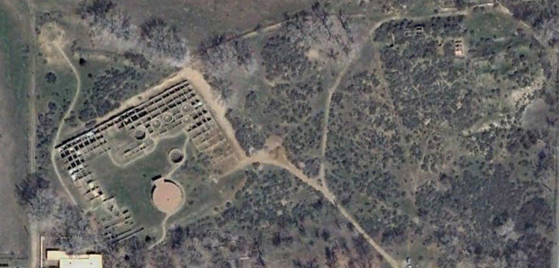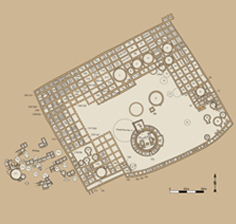Chaco Sites
Aztec West Ruins


Using this Map:
Click on the map image to launch full-size, interactive map.
When you select an individual room or kiva context on the larger map, a pop-up window will appear displaying information categories from our database available for that context (Artifacts, Burials, Tree-Ring Dates, and Features).
Each of the categories can be expanded by clicking the ‘+’ to reveal an abridged list of basic information. Selecting the category heading itself will open a separate window with complete details.
Site Description
Aztec Ruins National Monument encompasses several discrete structures, most notably Aztec West, Aztec East, Earl Morris Ruin, the Hubbard Tri-wall structure, several unexcavated mounds in the eastern portion of the site, and a large community of sites on the terrace north of the main ruin (Aztec North). Aztec West is the best-known and most thoroughly excavated of the buildings and, as a result, the majority of information collected by the Chaco Research Archive pertains to that great house.
Constructed between about A.D. 1085 and 1120 (with the greatest activity between A.D. 1110 and 1120), the multi-story West Ruin, with about 400 masonry rooms, 12 kivas, one great kiva, and D-shaped site plan, has all of the classic features of a Chacoan great house. Earl Morris excavated several rooms, kivas, and the great kiva for the American Museum of Natural History beginning in 1916 and continuing for several more years. Morris avidly collected wood samples at Aztec for the new science of dendrochronology (tree-ring dating).
Located 150 yards (137.2 m.) northeast of Aztec West, the East Ruin consists of two adjacent mounds about 16 feet (4.9 m.) high and approximately 300 feet (91.4m.) east to west. There has been sporadic excavation in East Ruin by National Park Service personnel for repair and maintenance, but no large-scale, systematic excavations. In 1927, 10 rooms were cleared by Morris, but no notes remain. Estimates from National Park Service mapping of the East Ruin suggests approximately 156 rooms and 15 kivas.
The Aztec complex played an important role during the last stages of the Chaco world and may have been built by immigrants from Chaco Canyon. One or both great houses flourished for more than a century, but were unoccupied after about 1275 concurrent with the depopulation of much of the Four Corners region. The site is also known as LA 45.
Excavation History
- 1916-1922: Earl Morris excavations at Aztec West
- 1927: Earl Morris excavations at Aztec East
- 1934: Reconstruction of the Great Kiva at Aztec West by the National Park Service
- 1930's through today: Sporadic excavation of both Aztec West and Aztec East related to site improvements and maintenance by National Park Service personnel
Size and Dates
- Aztec West includes at least 400 multi-story rooms, 12 kivas, and one great kiva. Aztec East contains about 156 rooms and 15 kivas.
- Tree ring dates place construction of Aztec West between A.D. 1085-1120; the great house was occupied until the last part of the 13th century
Site and Room Data
- Aztec West Ruins
- Bc 50 - Tseh So
- Bc 51
- Bc 53 - Roberts' Site
- Bc 57
- Bc 58
- Bc 59
- Chetro Ketl
- Pueblo Bonito
- Pueblo del Arroyo
- Shabik'eshchee
- Talus Unit #1
